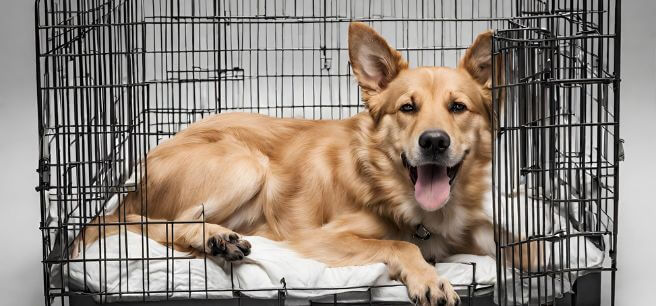When our furry companions undergo medical procedures or have injuries, they may need to wear a cone, also known as an Elizabethan collar, to obstruct them from licking or biting at the affected area. Concurrently, many dog owners opt for crate training to manage their pet’s behavior or provide a safe space. But what happens when these two come together? Can a dog sleep in a crate with a cone? Let’s delve into this topic and explore the considerations involved.

Understanding the Use of a Cone for Dogs
Before diving into the compatibility of a cone with a crate, it’s essential to understand why dogs wear cones. Cones are typically used post-surgery or during the healing process of wounds or skin conditions. They prevent dogs from accessing and aggravating the affected area, aiding in faster recovery and reducing the risk of infection. While cones may seem uncomfortable or cumbersome to dogs, they serve a crucial purpose in their healing journey.
Purpose of Crate Training
Crate training serves as a multifaceted tool for both dogs and their owners:
- It offers dogs a safe and secure space akin to a den, where they can retreat for rest. This designated area not only provides comfort but also aids in managing their behaviour by offering a consistent environment for training and discipline.
- Crate training is invaluable for housebreaking puppies or dogs, as the confined space encourages bladder and bowel control by discouraging soiling in their sleeping area.
- Crates are beneficial during travel, providing a familiar and secure space for dogs in unfamiliar surroundings.
Moreover, crates can be vital during recovery from illness or surgery, offering a controlled environment that promotes healing and prevents further injury. When introduced gradually and positively, crates become a place of comfort and refuge for dogs, enhancing their overall well-being. Ultimately, crate training fosters a sense of security and routine for dogs while facilitating a harmonious relationship with their owners.
Can a Dog’s Sleep in a Crate with a Cone?
The question arises: Can a dog comfortably sleep in a crate while wearing a cone? The answer depends on various factors, including the size of the crate, the dog’s comfort level, and the severity of the medical condition. In most cases, dogs can sleep in a crate with a cone, but specific considerations must be addressed to ensure their well-being.
One primary concern is the size of the crate relative to the dog’s cone. If the crate is too small or narrow, it may cause discomfort or restrict movement, making it challenging for the dog to find a comfortable sleeping position. Therefore, choosing an appropriately sized crate that allows the dog to move around freely without hindrance from the cone is crucial.
Tips for Ensuring Comfort and Safety
Make sure comfort and safety for your dog is primary for their overall well-being and happiness. Here are some essential tips to keep in mind:
- Provide Adequate Shelter: Ensure your dog has a comfortable and sheltered space to rest indoors and outdoors. A cosy bed or crate can offer security and warmth, while outdoor areas should provide shade and protection from harsh weather conditions.
- Systematic Veterinary Check-ups: Schedule regular visits to the veterinarian to ensure your dog’s health is monitored and any potential issues are addressed promptly. Vaccinations, parasite control with and dental care are vital to maintaining your dog’s well-being.
- Proper Nutrition: Feed your dog’s a balanced and nutritious diet suitable for their age, breed, and activity level. Avoid feeding them table scraps or foods that may harm their health. Adequate hydration is also crucial, so always ensure they can access fresh water.
- Regular Exercise: Engage your dog in regular exercise and play to stimulate them physically and mentally. Daily walks, interactive toys, and training sessions are great ways to give mental and physical stimulation while strengthening the bond between you and your dog.
- Grooming: Maintain your dog’s grooming routine by brushing their coat regularly, trimming their nails, and cleaning their ears and teeth. This keeps them looking their best and prevents health issues such as matting, infections, and dental problems.
Safe Environment:
- Create a safe environment for your dog’s, both indoors and outdoors.
- Remove hazards such as poison plants, small objects that could be devoured, and electrical cords that pose a danger of injury.
- Secure fences and gates to obstruct escapes and provide supervision in unfamiliar or potentially dangerous situations.
- Identification and Microchipping: Assured your dog wears a collar with identification tags containing your contact information. Additionally, consider microchipping your dog as a reliable form of permanent identification in case they become lost or separated from you.
- Socialization: Introduce your dog’s to various people, animals, and environments from a young age to promote positive socialization. This helps prevent fear or aggression towards unfamiliar situations and fosters a confident and well-adjusted dog.
By following these tips, you can create a nurturing and safe environment that promotes your beloved canine companion’s health, happiness, and well-being.

Alternatives to Crate Confinement
While crate confinement can effectively manage a dog’s behaviour and provide a safe space, there are better options for some situations. Fortunately, several alternatives to crate confinement can offer similar benefits while catering to your dog’s individual needs. Here are some other options to consider:
- Designated Room or Area: Instead of using a crate, select a specific room or area of your home where your dog can safely spend time unsupervised. This could be a spare room, laundry room, or larger living space gated-off section. Ensure the area is free from hazards and provides adequate space for your dog to move around comfortably.
- Playpen or Exercise Pen: A playpen or exercise pen provides a secure and enclosed space for your dog to roam and play without the constraints of a crate. These pens come in various sizes and configurations, allowing you to customize the space to suit your dog’s needs.
- Baby Gates: Use baby gates to blocked off areas of your home that you don’t want your dog to access. This allows your dog to move freely within a designated space while providing boundaries and preventing access to off-limits areas.
- Dog-proofed Room: Dog-proof a room by removing potential hazards such as toxic plants, electrical cords, or small objects that could be swallowed. Furnish the room with comfortable bedding, toys, and water to create a safe and inviting space for your dog to relax.
- Pet Sitter or Doggy Daycare: If you need to leave your dog for extended periods, Envisage hire a pet sitter or enrolling them in a dog daycare program. This allows your dog to socialize and interact with others while receiving supervision and care in a home-like environment.
- Dog Walker: Hire dog’s walker to take your dog for regular walks and provide companionship and exercise while you’re away. This helps break up the day for your dog and prevents boredom or anxiety associated with being left alone for long periods.
- Training and Behavior Modification: Invest time and effort in training and behaviour modification techniques to address any underlying issues that may contribute to the need for crate confinement. Positive reinforcement training can help teaching your dog appropriate behaviours and build a strong bond between you and your pet.
- Consult with a Professional: If you need clarification on the best alternative to crate confinement for your dog, consult a professional dog trainer or behaviourist. They can assess your dog’s needs and recommend a personalized approach that promotes their well-being and addresses behaviour concerns.
By exploring these alternatives to crate confinement, you can find a solution that meets your dog’s needs while providing them with a safe and pleasant environment to thrive in.
FAQs
With proper precautions and monitoring, many dogs can sleep in a crate with a cone overnight. However, it’s essential to ensure their comfort and safety.
The duration a dog needs to wear a cone depends on the severity of the condition and the veterinarian’s recommendations. It’s essential to follow their guidance.
Alternative options include inflatable collars or specialized garments designed to prevent dogs from accessing certain areas.
Most dogs can eat and drink with a cone, but it may require adjustment. Elevated food, water bowls can make it easier for them to access food and water.
If your dog appears uncomfortable or distressed while in a crate with a cone, it’s essential to assess the situation and potentially seek advice from a veterinarian.
Conclusion
In conclusion, while a dog can sleep in a crate with a cone, several factors need to be considered to make sure their comfort and safety. By selecting the right crate size, providing adequate padding, and monitoring the dog closely, owners can create a conducive environment for their furry friend to rest and recover comfortably.
Your feedback matters! Please let me know how I did with a thumbs up!
Amazon and the Amazon logo are trademarks of Amazon.com, Inc, or its affiliates.